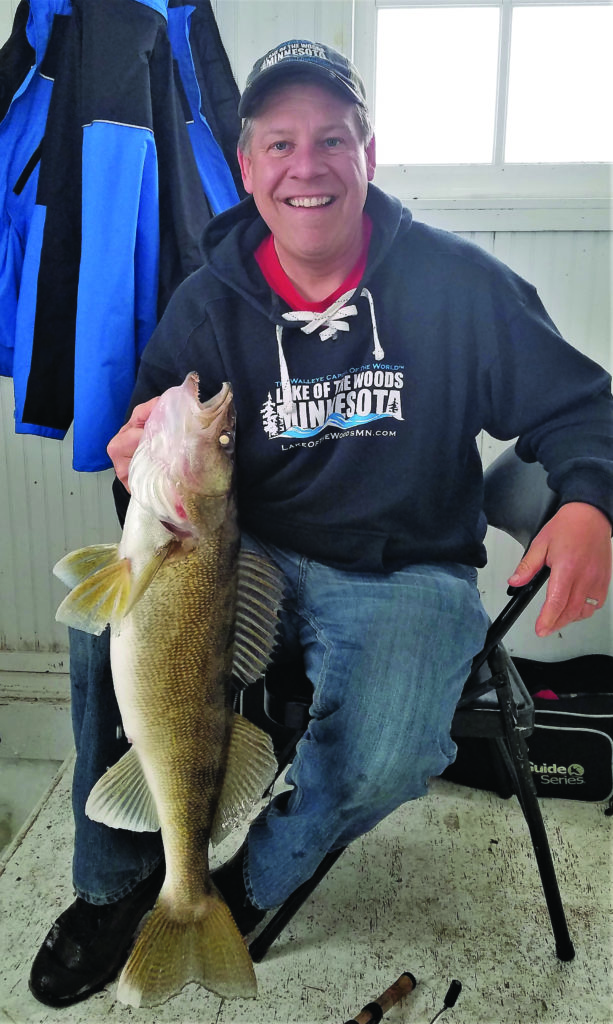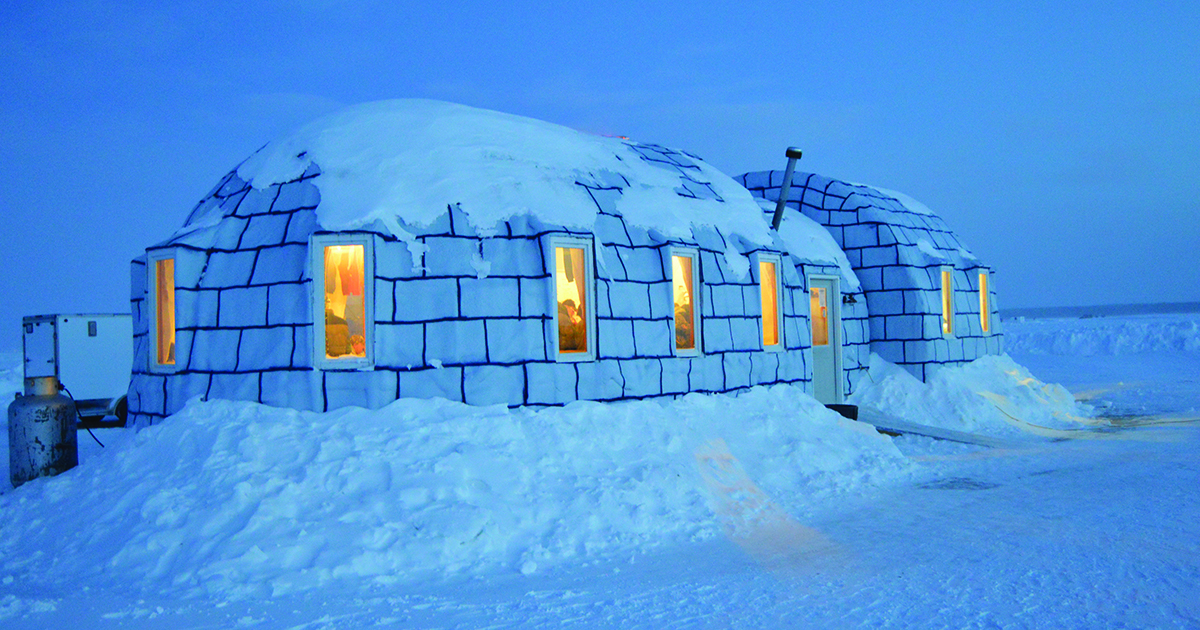Thousands flock every winter to Lake of the Woods to enjoy some of the best ice fishing in North America. Most take advantage of the unique infrastructure that has been created, traversing from a heated resort into a heated ice rig to a heated fish house without lifting a finger. Others prefer the challenge of doing it on their own with their own equipment, either driving out on a plowed ice road or navigating on a groomed snowmobile trail more than 40 miles across the lake or Rainy River. There are many options in these parts. What most visitors don’t realize is what happens behind the scenes to make this harsh winter environment a very comfortable ice fishing mecca.
Prepping for the winter season for some resorts and sleeper-fish-house businesses is a year-round process. For most, though, the process starts up around the end of summer. Resorts begin the by getting their ice fishing vehicles, trailers, fish houses and other equipment ready for the upcoming ice season. For the many fish houses, there is painting, adding new skids, repairs, checking heaters, fixing windows and a myriad of other tasks that are all part of the process.
A large piece of this operation is the decision of how many houses to retire from the fleet. Some of these fish houses have seen 40 below zero temperatures, gale force winds, thousands of fish, and have been the stage for families and friends making lifelong memories.
From a mechanical perspective, light ice rigs, such as Geo Trackers with heated trailers, are the norm for transporting people out to the fish houses early in the season. These rigs are fixed up, tuned up, welded and made operational so that when that first ice forms in early December, they are ready to roll.
As the ice thickens, many resorts will transport visitors in a bombardier, or possibly a homemade track rig. These rigs allow clearance over large snow drifts and exceptional off-road capabilities with tracks instead of tires. The vehicles are typically steered with big skis on the front of the vehicle, similar to snowmobile skis, rather than tires that would get stuck in the deep snow. Fully heated, they are part of the experience of ice fishing The Walleye Capital of the World.

In early December when the ice finally forms, resorts all around the lake are working hard to mark trails and search for the thickest ice. Oftentimes, some of the more aggressive and experienced ice guides are navigating out on just a couple of inches of ice to check its progress. This is discouraged for the majority, but for these few ice guides, they take many safety precautions and have done it for years.
When the ice reaches about 3 inches thick, most resorts use chainsaws to check the thickness of the ice. The guide bar of the chainsaw is marked off in inch increments. While slowly cutting down into the ice, the workers can tell when the water begins to spray up just how thick the ice is by how deep into the ice the bar is. It’s a quick way to check the ice in a variety of different spots while staking out safe trails.
In some cases, an ice road might cross a stretch of land that separates a bay from the main lake, such as Pine Island and Zippel Bay on the south shore. These crossings are made up primarily of sand. As soon as they can make it across the bay, resorts that have a road or bombardier trail will actually cut a hole in the ice and pump water into the sand. By soaking the sand with the water, travel is easier and it reduces wear and tear on fish houses and other equipment. This is normally done on very cold days so that the road will freeze hard, making it easier to cross the island.
Once out onto the main part of the lake, the ice is usually more consistent than the bay ice. Sometimes, when there is a strong wind when the ice is forming, there can be areas of really rough ice. The guides will chop it down and then flood it, to make the ice road as smooth as possible. In addition, some resorts will drag the ice with a heavy steel grid each time they drive out to shave the ice and smooth it out if it is too rough.

There are also a few pilots in the area that will fly over the lake to observe and take notes on what parts of the lake freeze first, what part of the lake stays open the latest and where there might be rough ice. These reports give resorts some help to stake trails on the thickest and most consistent ice. Resorts continually test the ice out to fertile fishing grounds. By closely monitoring the ice every day, they know when it is all right to allow the first travel by ATVs with collapsible fish houses. After a short time of cold weather, resorts begin to take out the first few fish houses. These first ones out, in many cases, experience some of the best fishing of the year.
Typically around Dec. 15, the snowmobile trails are staked from the mouth of the Rainy River across the lake to the Northwest Angle to the north, Warroad to the west, and to Baudette along the Rainy River to the south. These trails really open up more travel to the many resorts in the Northwest Angle.
Gregg Hennum, owner of Sportsman’s Lodge, stakes and grooms the trails himself. “We actually have six snowmobiles the day that we mark the trail. Two sleds haul trailers with the stakes. Two more go ahead and drill holes that are about 2 inches in diameter, while the other two follow and stick in the marker poles,” explained Hennum.
The poles are colored black with reflective tape around the top, not only to see the trail, but the black marker helps some melting in the warmer weather. “With those black markers, the ice around the marker melts nicely in the spring, allowing us to pull them out while moving along at a nice clip on a snowmobile. We have one person drive while the other will sit on the back of the snowmobile and pull the trail markers,” Hennum said.
Nick Painovich, owner of Zippel Bay Resort, will also be preparing for the busy ice season. He, like many resort owners, is one of the first people out early on thin ice checking conditions and staking a trail. “I invested in an airboat a number of years ago to make things easier on me. This way, as I am checking ice through Zippel Bay and eventually out on the main lake, I have a sense of security.” He places flags in the areas that he has checked that are coming along nicely, and a double flag in areas that are a bit thinner.

With the goal of thicker ice, Painovich sometimes helps Mother Nature out a bit. “Out in the open areas, we get some wind that blows the snow off the ice, creating thicker ice. Back in the narrow parts of the bay, the wind doesn’t hit those areas so much and snow starts accumulating. Because of this, I will take out my airboat and give it some power, blowing much of the snow off of the ice, which allows it to freeze quicker.”
Zippel Bay Resort is famous for their Igloo Bar out on the ice. This oversized fish house is designed in the shape of an igloo. With more than 1,000 square feet on the inside, electric lights, big screen TV, full bar and partial food menu, it’s definitely a popular gathering spot for visitors. Did I mention that you can actually fish inside the bar? Each winter, big pike over 40 inches are caught, along with some nice walleyes right out of the bar. I mentioned to Painovich, “It gets pretty festive when someone catches a fish in the Igloo Bar.”
“You should see what happens when someone loses one,” he replied.
“We take the Igloo Bar out in two pieces, and use a come-along to pull the pieces together when the bar is in the right spot. We need about 15 inches of ice to bring it out,” explained Painovich. “We also prepare the ice some before setting the igloo. I actually will build a snow bank around the spot where the Igloo Bar will be placed. I punch a hole in the ice and pump lake water on the ice to flood it. I will build this spot up, actually forming a crown on the ice of 3 to 4 inches, also giving the ice more strength.” Painovich added that the Igloo usually gets out on the ice before Christmas.
Yes, the winter months on Lake of the Woods are filled with plenty of ice fishing. When you are able to make the trip up, give an extra thought about all of the work that it takes to make this area an ice fishing mecca.
For more information on lodging, snowmobiling and ice fishing on Lake of the Woods, contact Lake of the Woods Tourism at 800-382-FISH (3474) or at www.LakeoftheWoodsMN.com.


